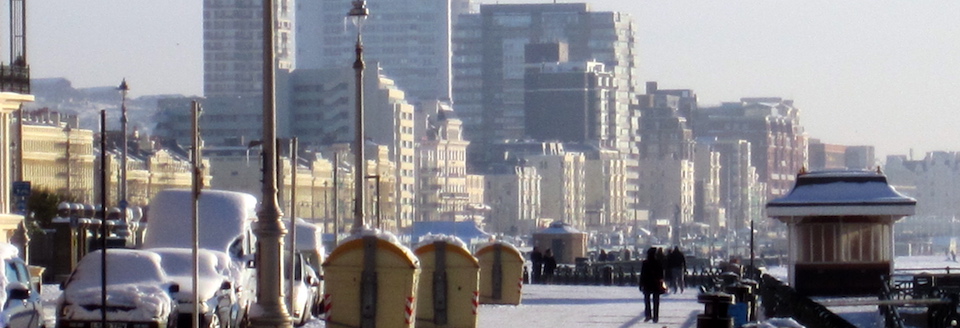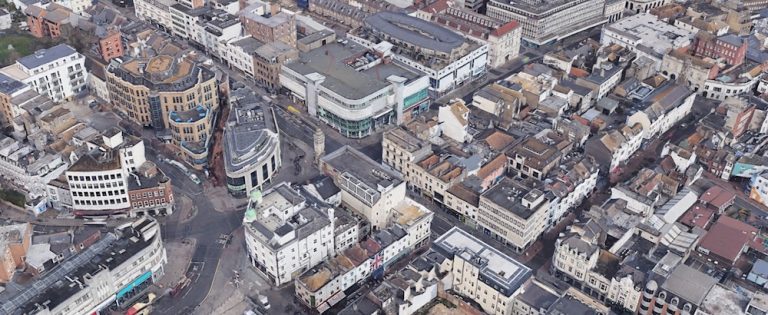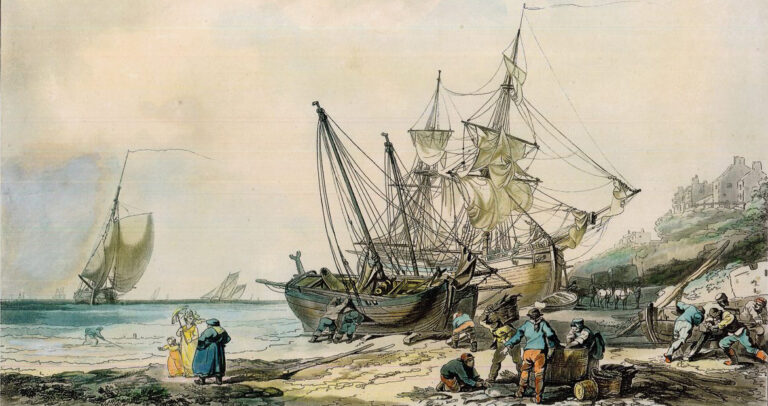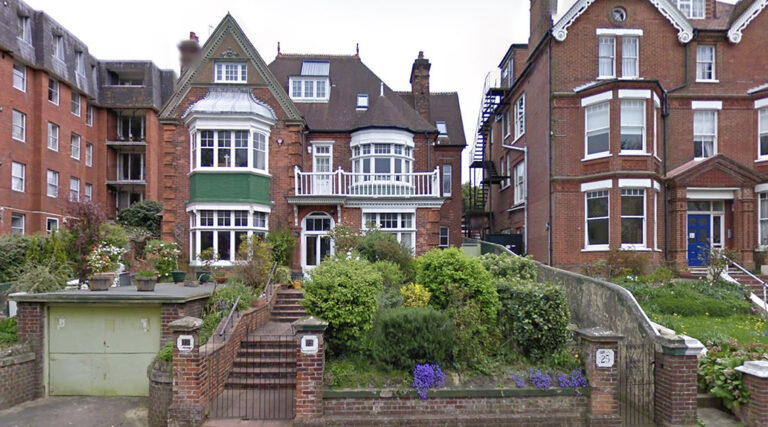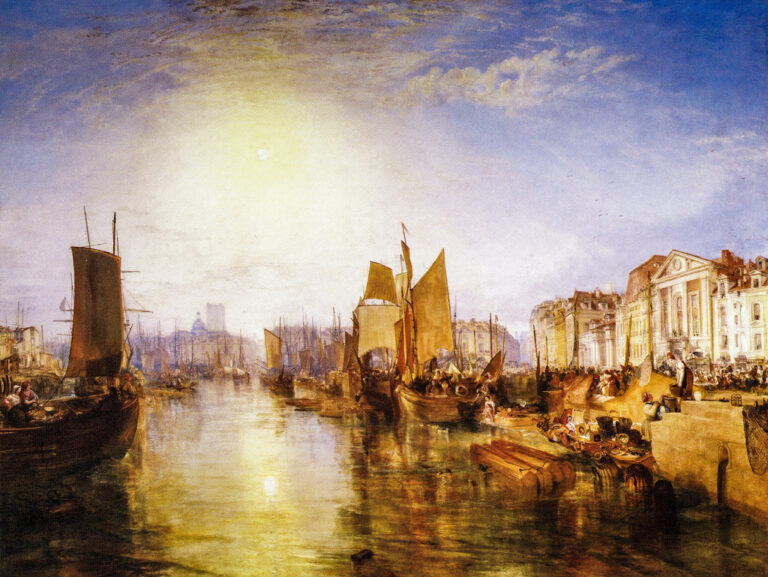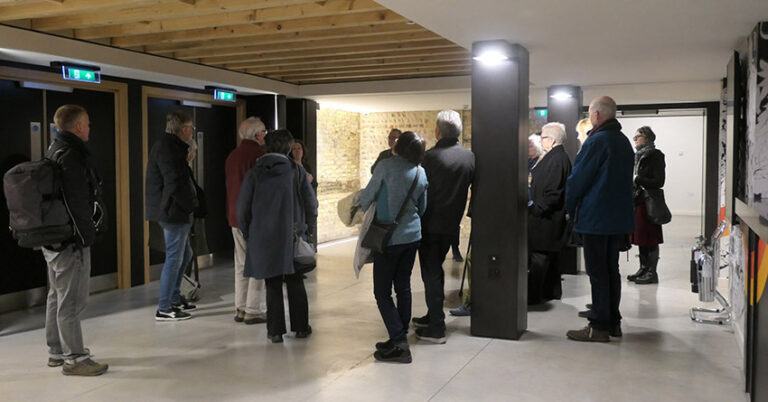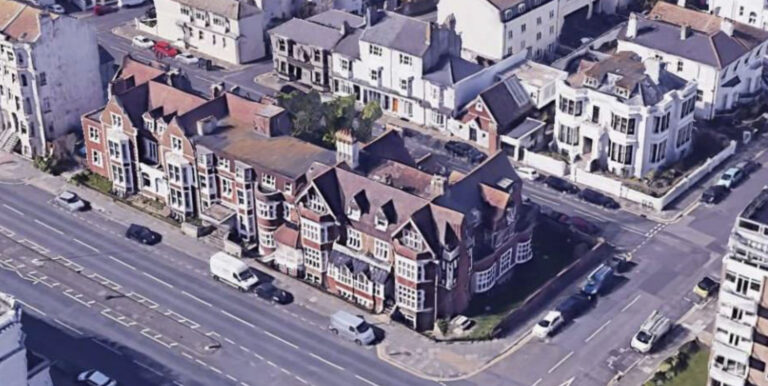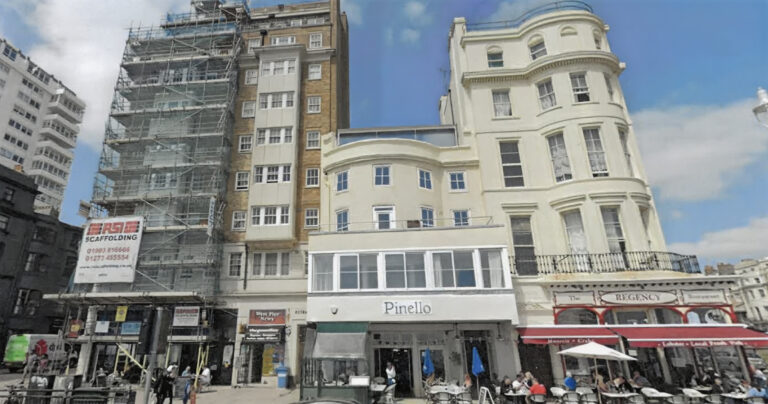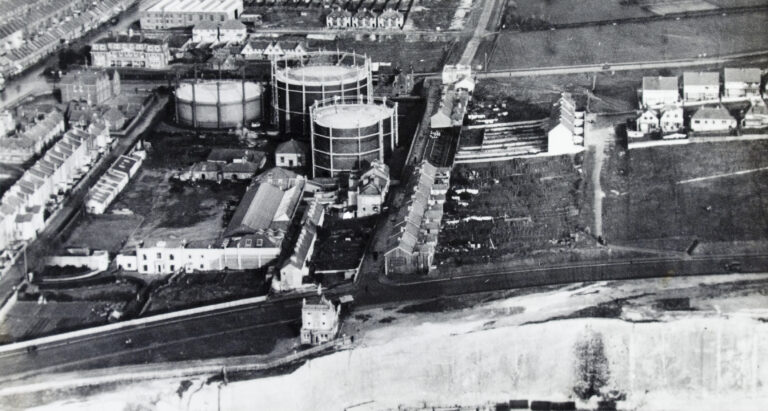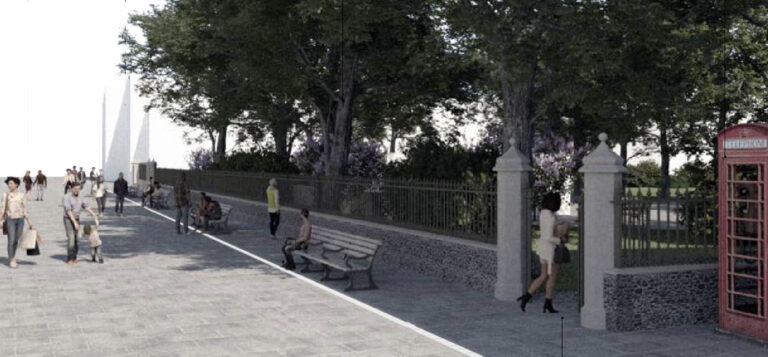This page is updated regularly with news of our latest activities and concerns. Articles are in chronological order (latest first). To find articles on particular topics go to 'Browse news' (right).
News
Tudor to early Georgian Brighton
An ever-changing town c1540-1780
The Regency Society presents its first summer school: a series of five seminars conducted by Dr Sue Berry.
Brighton’s history from the reign of Henry VIII onwards demonstrates how a town’s ability to respond to challenges wrought by external influences affects both the chances of it prospering or declining and shapes the townscape. Anyone who has ever attended any of Sue's seminars and talks will know how lively and informative they are. You can read the course summary here: Tudor to early Georgian Brighton.
The seminars on five consecutive Tuesday mornings from 11 June to 9 July 2024 at 10:30-12:30 will be held at the Friends Meeting House, Ship Street, Brighton BN1 1AF. The series of all five lectures costs £25.00. Numbers are limited to 25, so early booking is advised.
To book through Eventbrite follow this link.
Image: Fishermen Returning to Brighton [RS/Brighton Society of Print Collectors]
Preserving the streetscape
The Joint Planning Forum of the Regency Society and Hove Civic Society has objected to the following application.
BH2023/00690: 25 Preston Park Avenue, Brighton BN1 6HL. Variation of condition 2 of BH2020/02934 to allow amendments to cycle store and replacement of green roof with solar panels.
25 Preston Park Avenue is a surviving Victorian villa within the Preston Park Conservation Area facing onto the Grade II listed park and garden of Preston Park. Part of the character of the conservation area on this street is the large front gardens that slope up to the houses on a raised level facing down to the park, which contributes to the green space of the park.
BH2020/02934 allowed on appeal the conversion of No 25 into seven flats and the construction of two new houses in the back garden, the subject of the appeal and of the application to change the roof.
Permission was given to replace a single garage in the left-hand half of the frontage by a two-car hard-standing. The current retrospective application is to create two similar parking bays on the right hand side.
The proposed alterations will result in more of the front garden being used for storage of bikes, bins and car parking and a reduction of the size of the front garden area. It also will result in the bin and cycle and bin storage being closer to the front boundary of the property and therefore more conspicuous in the conservation area. The additional two parking bays will result in loss of green landscaping, as well as a significant loss of planting that contributes to the character of this street and its front gardens. The previous proposal as approved by the inspector included three trees: a cherry tree and two silver birches. These would be removed to make way for two additional parking bays. There would also be a loss of the front boundary wall onto the garden, which is a feature of historic properties on this street.
The already approved landscape should maintained, or if additional storage space is required it should be to the rear of the building, where it is less visible from the public view in the conservation area. This proposal moves cycle storage from the rear to the front of the property. For this reason, the proposal would be harmful to the conservation area as a public asset with no public benefits.
Image: 25 Preston Park Avenue, built by George Burstow in 1899, before alteration [Source: Google]
Impressionist Tour 2024
A team from the Regency Society have designed this unique tour themed on the work of the Impressionists. Nearer the departure date we will all get together to learn more about the Impressionists whose paintings we will see and look at the same views through contemporary eyes.
Tuesday 10th – Saturday 14th September 2024
There is a limit of 24 places and the final booking is 31 st March
Day 1
We depart from our designated pick-up points in our private executive coach and travel to Newhaven with our tour manager for our DFDS mid-morning ferry crossing to Dieppe. The ferries have very recently been re-fitted and are very comfortable.
On arrival at Dieppe we disembark our ship and continue the short distance to the 4* Mercure la Presidence Hotel for a four night stay.
In the evening we meet together for dinner at a Quayside Restaurant.
Day 2
A guided walking tour of Dieppe looking at the views painted by artists like Sickert, Turner and Pissarro. Individually pick up something for lunch at one of the many Boulangère in the Grand Rue and board the coach to Les Bois des Moutiers the iconic house designed by Sir Edwards Lutyens, it has been closed for 5 years undergoing restoration, but we are promised it will open for visitors this summer.
He was great friends with William Morris and parties would come over from England and design the interior fittings. The gardens are by Gertrude Jeykll and are just fabulous and a good spot to eat our lunch. Then on a short drive to the beautiful little church in Varangerville with windows designed by Georges Braque and the churchyard where he is buried. This church is perched on the edge of the crumbling chalk cliffs so it may be your last chance.
Day 3
On arrival in Honfleur this morning we visit Musee Eugene Boudin, located in a 19th century chapel and named after the town’s most famous painter. The museum is home to a fine collection of impressionist works by artist such a Boudin, Dubourg, Monet and Jongkind. We them spend some time at Leisure in Honfleur to explore the town before returning to Dieppe.
In the evening we are guests for pre-dinner drinks in an interesting house in the heart of the oldest part of Dieppe.
Day 4
Today we enjoy a guided tour at the Musee des Beaux-Arts in Rouen, home to an outstanding collection of paintings, drawings and sculptures which includes many of the Impressionists.
The afternoon is at leisure in Rouen and on an individual basis you may choose to visit the Cathedral Notre-Dame a Gothic masterpiece that is dominated by the famous west façade. In the 1890’s Claude Monet made almost 30 paintings of the Cathedral. Nearby is a stunningly beautiful modern church with a vast stained-glass window made from the glass shards from a church bombed in the war.
Day 5
After checking out of our hotel, we enjoy some time at leisure in Dieppe. You can stock up on cheese and vegetables from the vast market that invades the town every Saturday and spend time in the Museum housed in the fortified castle. This is well worth a visit although you will have to buy your own ticket as it is not included in the tour. Later on in the day we will catch the early ferry back to our original pick up points.
Details
Price (including Breakfast): £995+/-
Single Supplement:£159.00 +/-
Date: Tuesday 10th – Saturday 14th September 2024 (5 days 4 nights)
Depart: Newhaven - Dieppe (depart: 09h30 | arrive: 14h45)
Return: Dieppe - Newhaven (depart: 18h00 | arrive: 21h00)
Coach: Executive coach throughout
Hotel: Mercure la Présidence Hotel 4* (or similar) at Dieppe
Facilities at the hotel include a bar, and all of our allocated Standard Rooms are en-suite and feature a television, and tea and coffee making facilities. A set 3 course dinner without drinks is included at a restaurant close to our hotel on the first evening, and the remaining three nights are on a bed and breakfast basis.
Rooms available: Twin/Double: 10 | Singles: 8
Included: 3 course meal on first evening, entrance fees to museums and places of interest featuring in the itinerary
Not include: Gratuities, lunches, local accommodation tax, dinners on days 2, 3 & 4, donations at any churches visited.
NB There are only 8 single rooms so, if you are coming on you own, maybe you would like to double up with a friend.
Both the boat and the Hotel are non-refundable and so we need a £200 deposit by 31st of March (Ref Regency Society of Brighton &Hove 40 52 40 00091590) which is the deadline for reserving the Hotel rooms.
Please email me fmlindsayhills@gmail.com when you send your deposit so I can reserve a room for you.
The cost of the tour is based on a minimum of 24 passengers travelling and so until we have the deposits, we cannot be sure that it will go ahead. If we don't get 24, of course, your deposit is fully refundable.
Insurance including Covid cover is costs £69 per person and available from our tour operator Tailored Travel info@tailored-travel.co.uk
Resplendent Corn Exchange
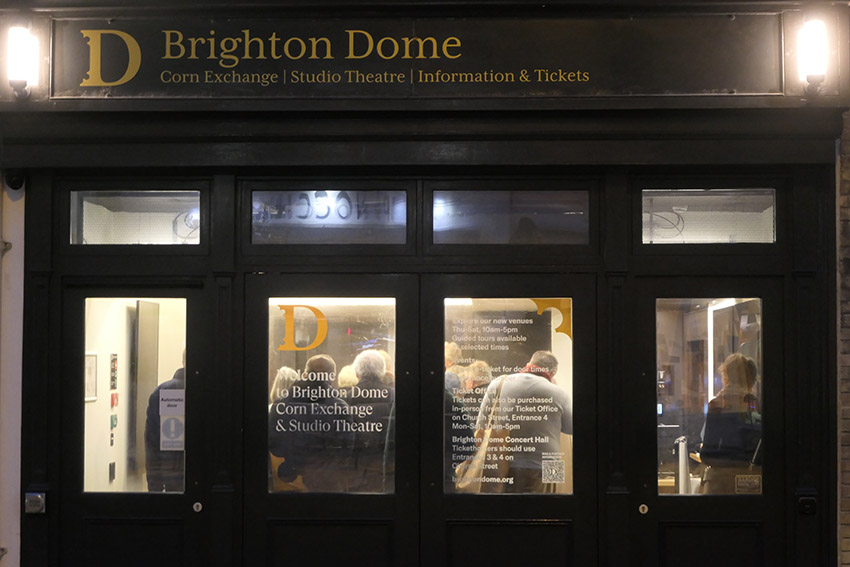
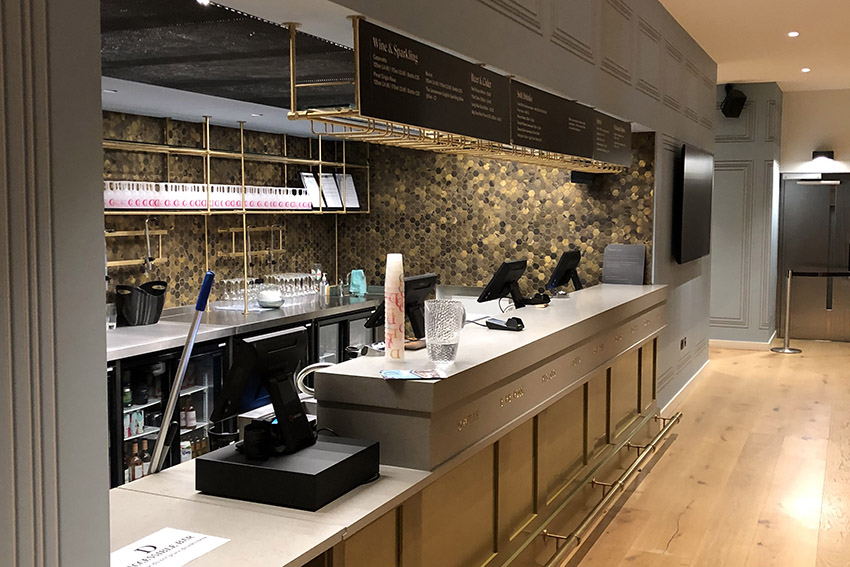
The 40 RS members who were fortunate enough to go on a tour of the Corn Exchange and Studio Theatre in February were unanimously impressed by the quality of the design and execution that has turned the once rather down-at-heel corner of Church Street and New Road into a set of resplendent spaces that will benefit the city for years to come.
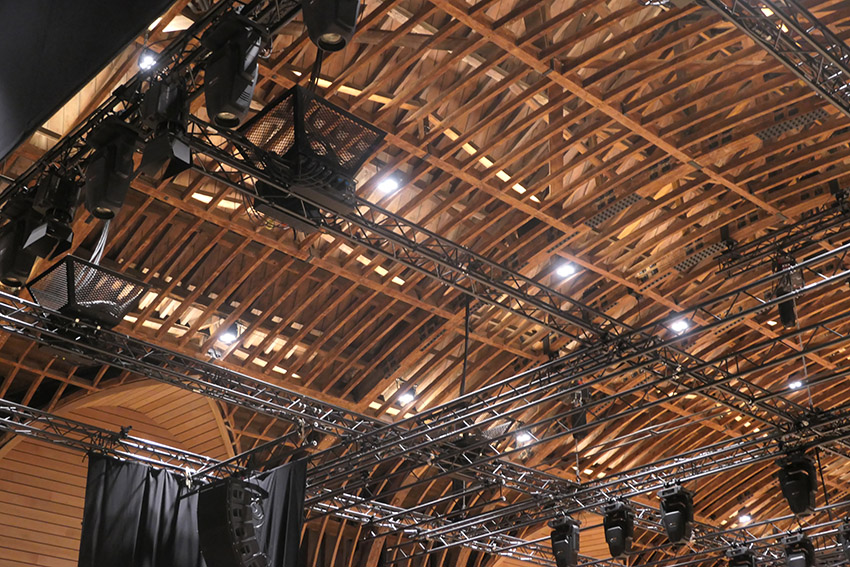
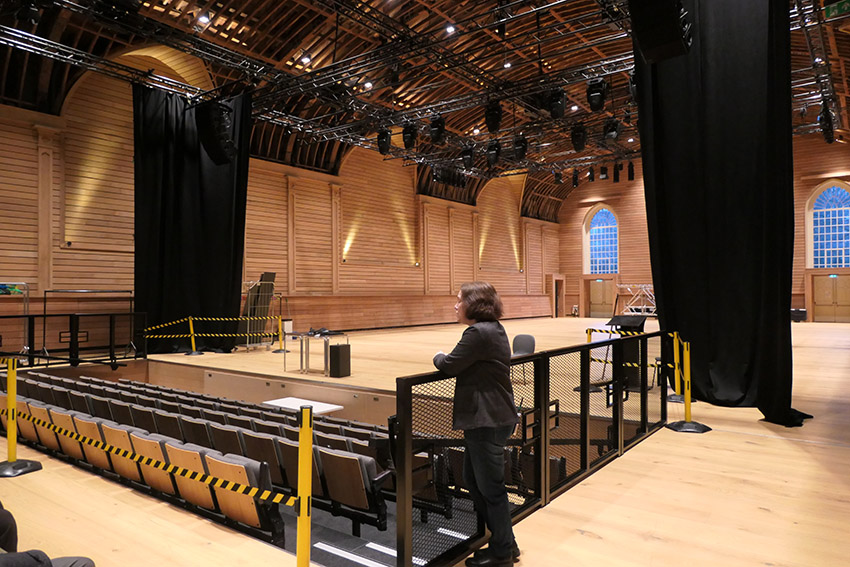
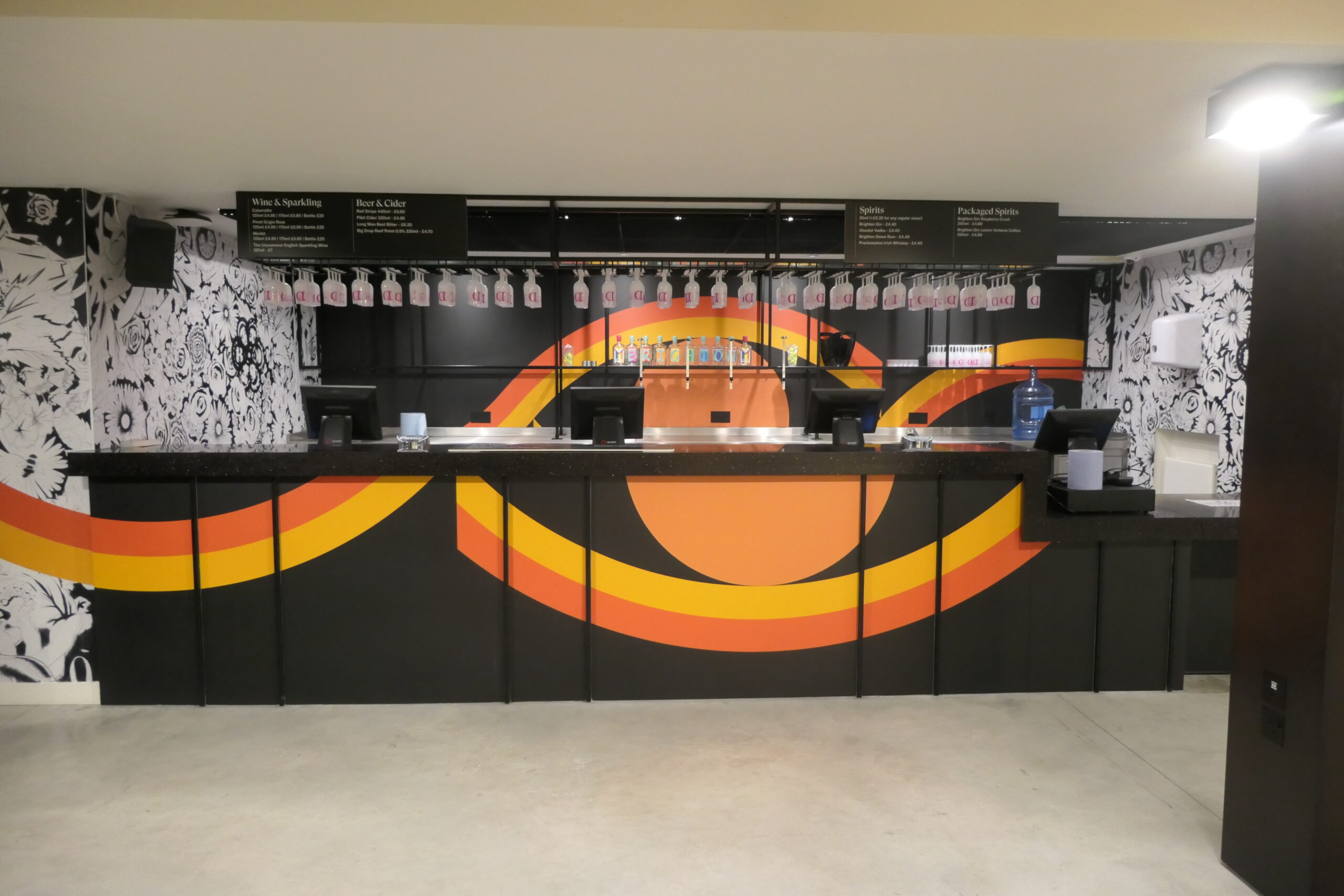
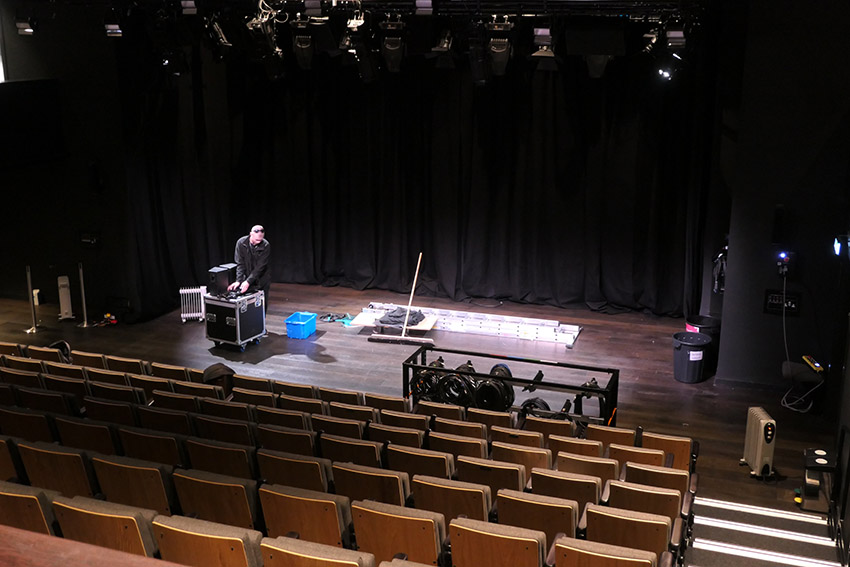
The architects for the project, Fielden Clegg Bradley, used considerable ingenuity and sensitivity to return the Corn Exchange close to William Porden’s original design for the Prince Regent’s riding school but suitable for use as a 21st century venue, as anyone who visited the Van Gogh Alive show will appreciate. The Studio Theatre is also considerably more inviting and practical than it was in the days that many will remember.
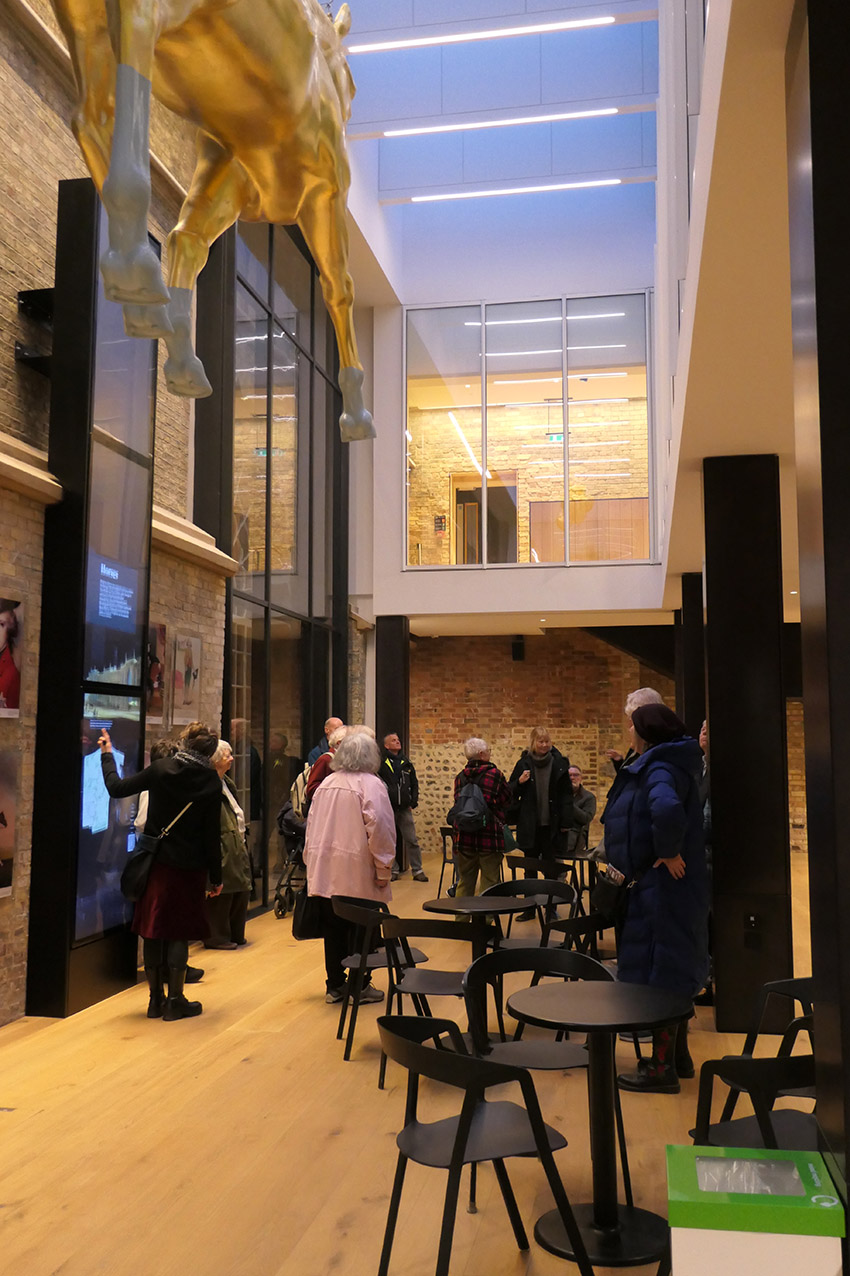
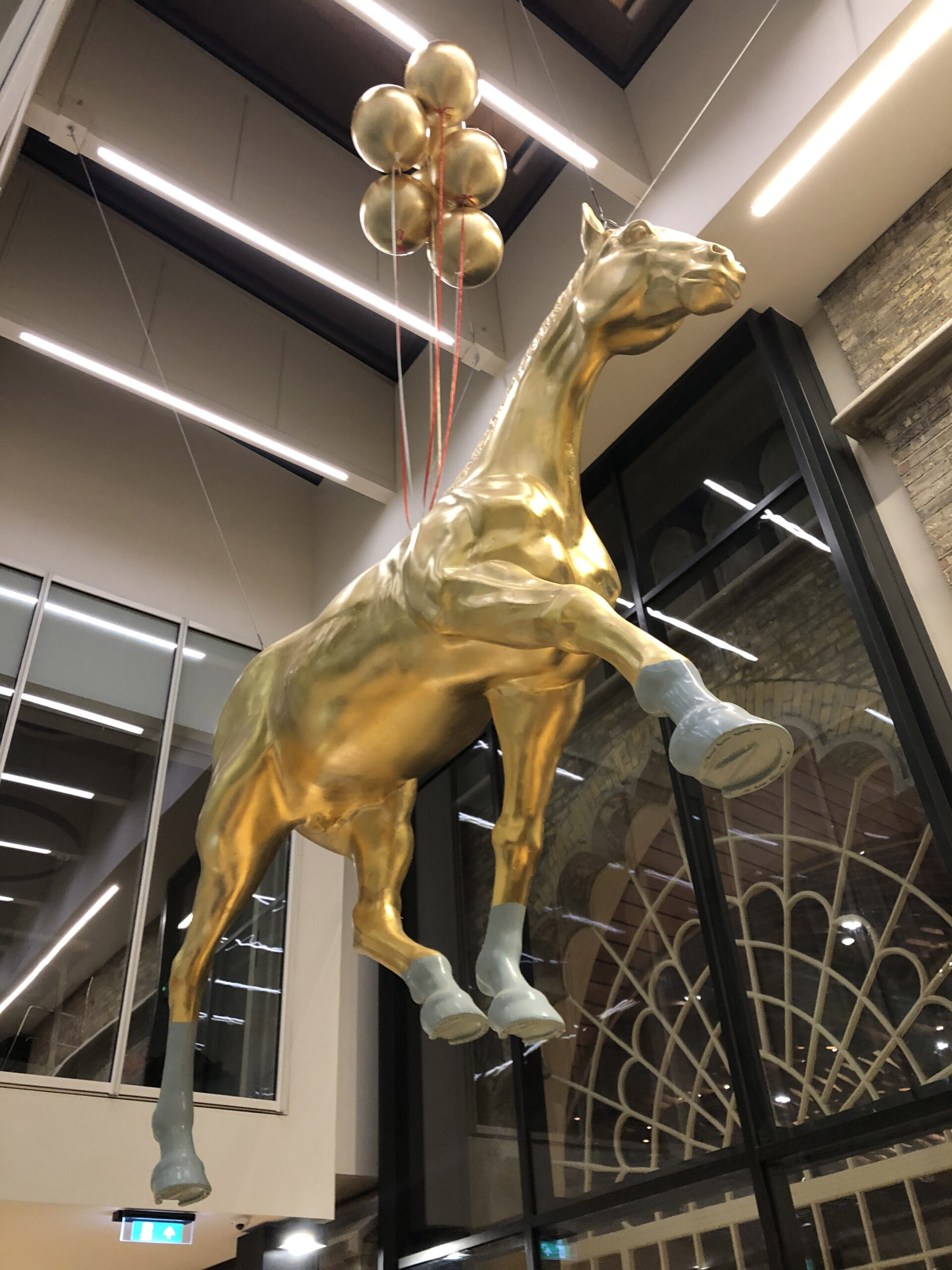
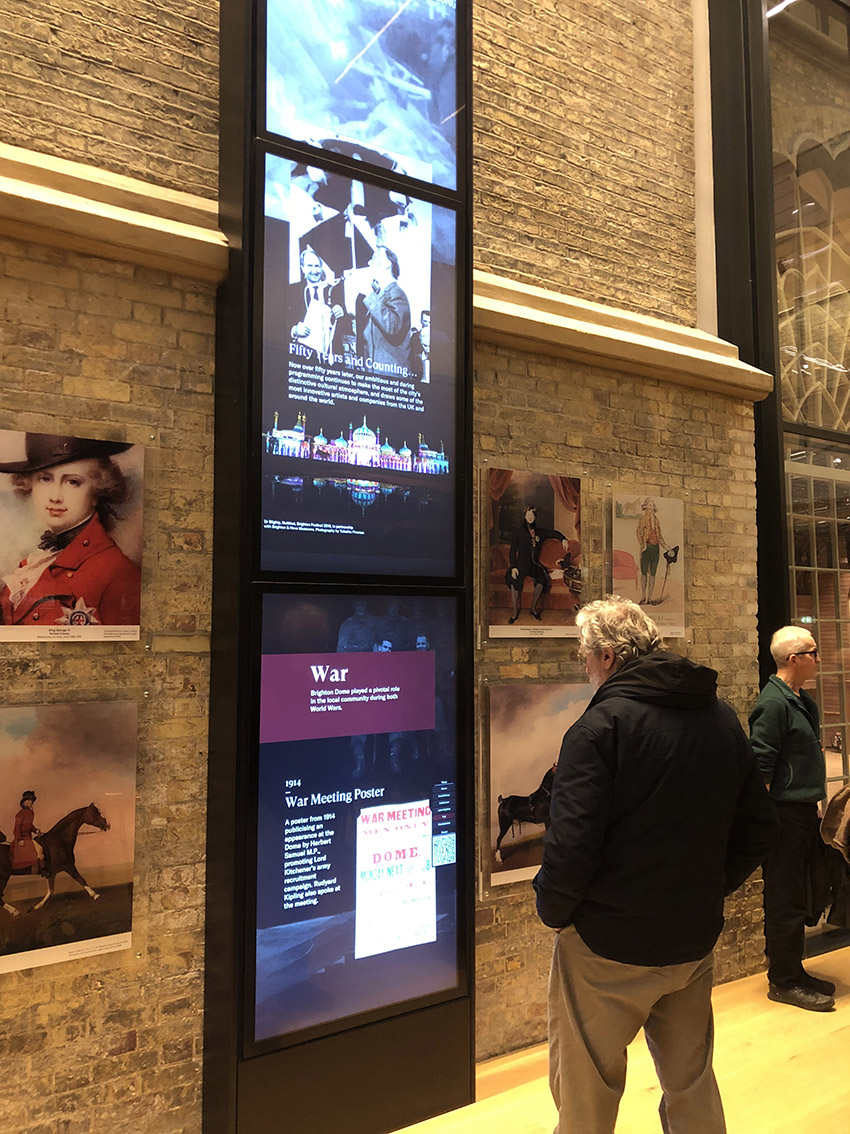 The reconfigured entrance from New Road and the circulation spaces it leads to—including the bar with its whimsical life-size golden horse ‘lifted’ by balloons—are fun as well as practical. The history of the building is now much more readable as a result, a lesson for other heritage restoration projects.
The reconfigured entrance from New Road and the circulation spaces it leads to—including the bar with its whimsical life-size golden horse ‘lifted’ by balloons—are fun as well as practical. The history of the building is now much more readable as a result, a lesson for other heritage restoration projects.
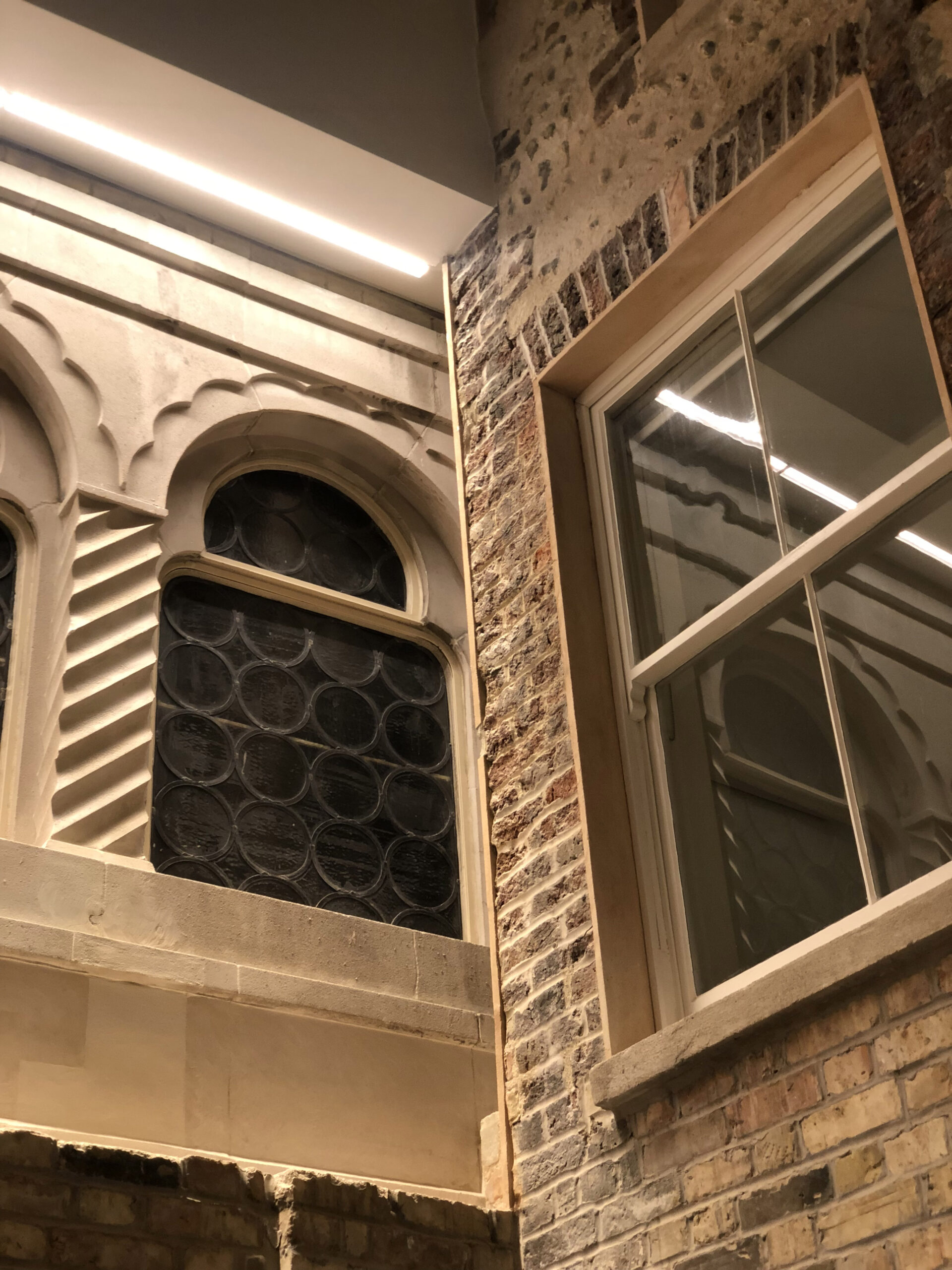
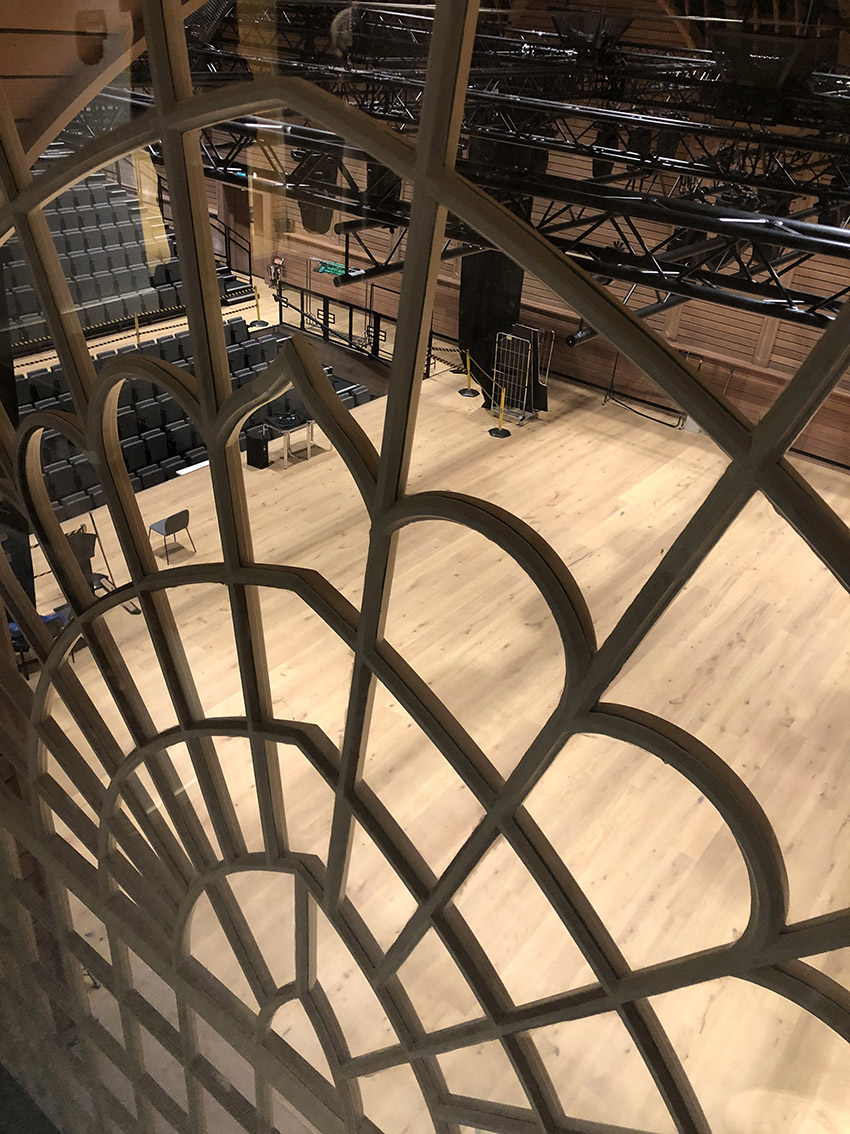
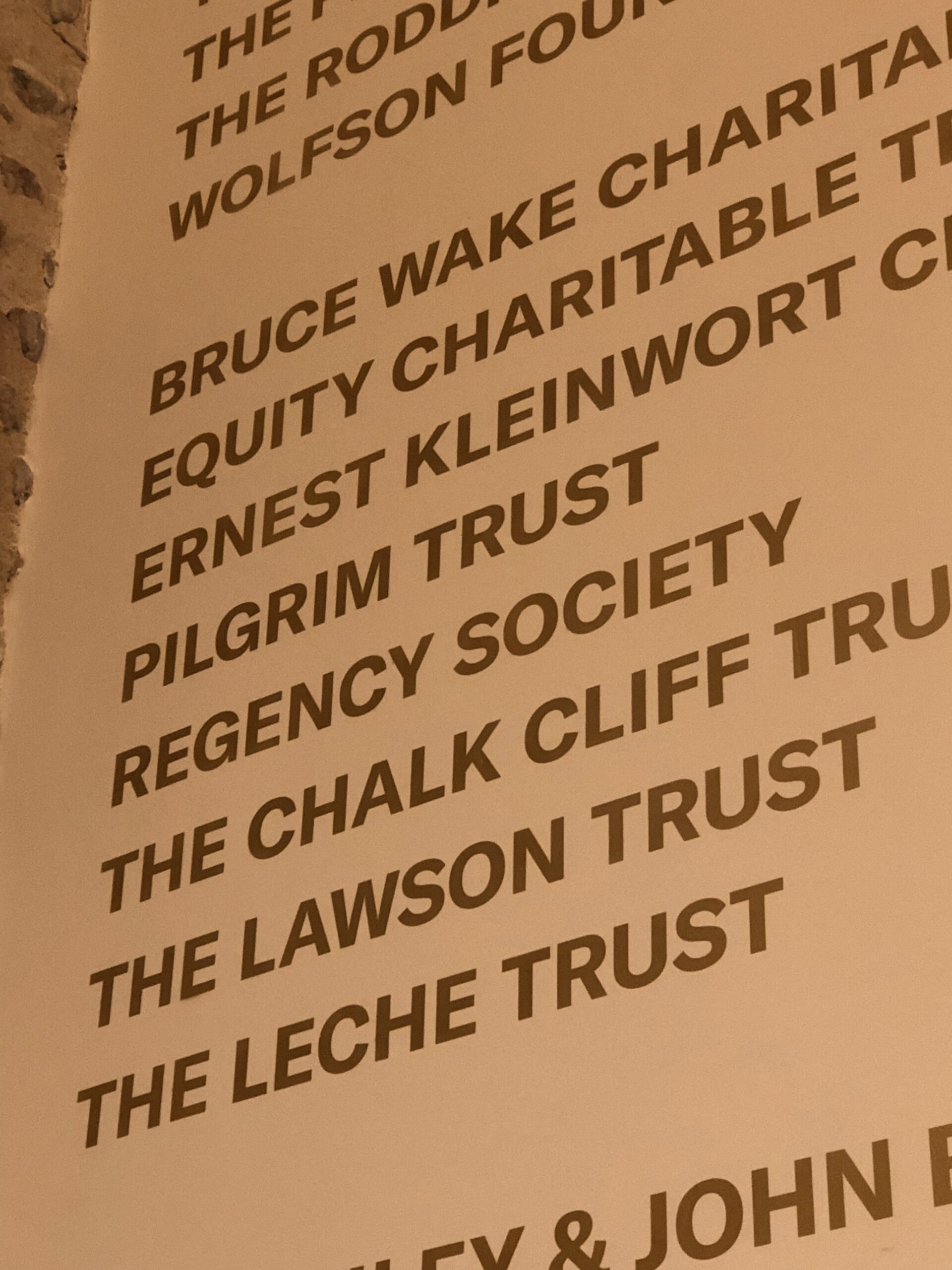 The Regency Society was one of the donors to the cost of restoration, for which we are recognised in a couple of places. Money well spent. Our grateful thanks to Maxine Hort, Director of Operations at Brighton Dome and Festival, as a most informative guide and to her colleague Kata Gyongyosi in support.
The Regency Society was one of the donors to the cost of restoration, for which we are recognised in a couple of places. Money well spent. Our grateful thanks to Maxine Hort, Director of Operations at Brighton Dome and Festival, as a most informative guide and to her colleague Kata Gyongyosi in support.
You can read our previous posts about the restoration:
Brighton Dome Corn Exchange: restoration to celebrate
The Refurbishment of Brighton Corn Exchange (talk).
Lucky early visitors view the Corn Exchange renovation
Photographs by David Sears and James Tulley.
Proposal for Hove hotel conversion is welcomed
This is the comment we have made about the conversion of the St Catherine's Lodge hotel to provide 36 residential units with external alterations, provision of cycle parking, removal of vehicle crossover and reinstatement of the footway to front and rear.
BH2023/03293 9-12 St Catherine’s Terrace, Hove BN3 2RH
The Regency Society and the Hove Civic Society are pleased to support the proposal for the conversion of the hotel to provide 36 residential units.
We commend the thoroughness in tracing the history back to its origins as two pairs of semi-detached villas and analysing the subsequent incremental changes.
We welcome the removal of disfiguring additions and the proposals for new area walls and railings in keeping with surviving original details.
We particularly applaud the sensitivity and care in restoring existing windows as well as creating new dormer windows and partial new roof consistent with the existing.
The creation of bicycle storage is also to be commended, especially in the way it is discreetly located.
No to another storey on King’s Road
This is the objection the Joint Planning Forum has submitted about the proposed development at what is now the Pinello restaurant near Regency Square. This comprises erection of an additional storey to create a two-bed flat with a front roof terrace, installation of a new lift and stairwell, internal alterations to the layout of existing flats and revised fenestration to front and rear elevations.
BH2023/03417 132 Kings Road Brighton BN1 2HH
The Regency Society and Hove Civic Society object to this application. The proposals would be detrimental to the architectural and historical interest of this unlisted heritage asset. They would have an adverse effect on the character of the Regency Square Conservation Area and on the setting of the adjoining Grade II* St Albans House and the locally listed Astra House, of the Grade II* Regency Square and of the Grade II South African War Memorial and the Shelter on the promenade opposite.
No 132 is the remaining half of a matching pair of late 1790s villas, the only survivor of the 18th century buildings between Preston Street and Regency Square and the oldest standing building in Kings Road, older than any of the listed buildings
The central Brighton seafront has long been characterised by abrupt variations in height, evidence of its historical development. The modest scale of No 132, built during the uncertainties of the French Revolutionary Wars, contrasts with the ambition of St Albans House, built in the peaceful years after the end of the Napoleonic Wars. 132 and 133 were originally brick faced but were modernised with stucco to match St Albans. A century later, Astra House was characteristic of the inter-war development of Brighton and Hove.
The fully glazed terrace-facing seafront of the penthouse, set 4 metres back from the apex of the full height bowed wall and 2.5 metres back from the chord of the bow and the front wall of the house, is completely out of character with the building itself, the conservation area and nearby listed buildings. Even a mansard roof would be incongruous in this location. The replacement of the UPVC second and third floor windows with timber sashes would be small compensation.
Except for the additional storey, the proposed alterations to the rear elevation have to be regarded as an improvement, while the internal alterations would be acceptable even if the building had been locally listed.
Image: The proposed seafront view, with Astra House on the left and St Alban's House on the right of the Pinello restaurant. {Source: the planning application]
Time to rethink the gasworks plan—again
The Regency Society has submitted the following comment about the latest proposals for the redevelopemnt of the Kemp Town gasworks site to Brighton and Hove City Council planning department.
BH2021/04167 Brighton Gasworks
The Regency Society of Brighton and Hove wishes to record its objection to the proposed development on the site of the former Brighton Gasworks.
The Society supports, in principle, the proposal to develop what is a derelict, polluted, brownfield site in an important location. However, it shares the concerns expressed by other responders about the risks arising from the process of remediation both during and after construction.
We also support, in principle, the developer’s stated aim to create a mixed community with a substantial number of much-needed homes.
We also welcome the attempt to create pedestrian links across the site and to connect the sea-front to Sheepcote Valley and the South Downs National Park. In this regard we regret the Council’s decision not to release the strips of land along the site’s northern and southern boundaries.
The present planning application dates from November 2023 and is the third to have been submitted by St Williams Homes (a subsiduary of the Berkeley Group). It offers a few changes to earlier submissions: the total number of dwellings has been reduced by 12 per cent; the height of one of the taller blocks has been lowered from 12 to 10 storeys; brick colours have been changed; the block in the northeast corner has been reconfigured to resemble a circular gas-holder. However, none of these changes really address the criticisms of the previous submission made by an overwhelming number of responders, including the Regency Society; nor do they mitigate what were considered to be its major flaws.
Perhaps the most significant change and one to be most welcomed, was the insertion of second staircases in ten of the blocks to meet post-Grenfell concerns about fire-escape
The Regency Society’s objections can be summarised under the following headings:
Response to the site and its location
The site is located at the eastern end of the Brighton seafront and forms an integral part of this unique heritage townscape. The applicant pays lip-service to Brighton’s heritage assets but the scale, urban form and architectural expression of their current proposal fail to take them into account: the buildings are too tall, too bulky, too crammed together; they are too much of a hotch-potch and lack any formal structuring or legibility. More specifically, they fail to respond to the scale and character of Regency Kemp Town (Arundel Terrace and Lewes Crescent) or to the clean modern lines of neighbouring Marine Gate. The applicant argues that the development does not impinge directly on distant views of the site, but this does not alter the fact that it occupies a key position in the overall composition of the seafront.
The scope of the development: density, mix, tenure
The site has an area of 2.02 hectares (c.110m x 200m). The proposed development comprises a total of 12 blocks varying in height from 3 to 12 storeys and containing 495 dwellings, giving a density of 245 dwellings per hectare (c.790 theoretical bedspaces per hectare), and a FAR (floor-area-ratio) of c.1.8:1. Such densities are high and, whilst they are comparable with other recent developments in the city, we believe them to be higher than the site can comfortably sustain. A target total of around 400 dwellings would be more acceptable. We also believe that the omission of the 14 row houses would have a marked beneficial effect on the overall footprint and would relieve the sense of congestion.
The applicant promises to create a ‘vibrant mixed community’ and we applaud their proposal to accommodate a variety of non-housing uses in the development. However, 84 per cent of the proposed dwellings have only one or two bedrooms and only 16 per cent can be described as being suitable for families with children. This sort of mix is being echoed in new developments across the city and will contribute to a serious demographic imbalance in the future.
The applicant states laudably that 40 per cent of the dwellings will be available for affordable rent, though this is only a target and it is unclear how it will be achieved.
We are also concerned that dwellings will be available on a 95-year lease and that the developer will retain the freehold and have full control over annual charges. This form of tenure has come in for much recent criticism.
Access and car parking
The scheme provides 179 car spaces (one for every 2.8 dwellings) and accommodates 629 bicycles. Residents will have to pay for parking spaces (quite substantially, if other recent schemes are anything to go by). It seems likely that many will elect to park on surrounding streets, thus exacerbating existing parking problems in the area.
The entrances to the various blocks are scattered around the site and it’s not clear how visitors, or indeed residents, will approach them. Where will visitors park? How will taxis or ambulances access the development? If one takes the example of Block 12 in the southeast corner, one wonders: how will disabled people access it, how will removal vans, delivery vans or ambulances service it?
The parking is located within two podia, one under the northern part of the site and one under the western part of the site. These are chaotically planned. The resultant entry sequences are also bizarre—particularly the entrances to Blocks B & C, which are via long, narrow windowless corridors. In similar fashion the town houses are connected to the parking basement by a long nightmarish corridor. None of this complies with generally accepted design and planning standards.
Building form
Whilst the developer pays service to heritage and what they call ‘social memory’, they fail to take on board the main characteristics of Brighton’s heritage seafront: its marine squares (a unique Brighton feature that can be seen from Adelaide Crescent in the west to Marine Gate in the east), its use of order and symmetry, and its consistent scale.
The 12 blocks are arranged in three ‘strings’ that run from north to south down the site and are separated by narrow corridors of space. This arrangement does not fit comfortably within the site width and results in narrow spaces between blocks (as little as c.16 meters) that will lead to problems of over-looking, noise and lack of privacy.
There is no formal structuring and the blocks all have different shapes, heights and sizes (and employ different materials and colours). It is as if a child had scattered toy bricks across the site.
The most incongruous element is the circular block next to the circus that has been configured, bizarrely, to mimic a green gasometer (with disastrous consequences for the planning of the flats that it contains).
The open space in the northeastern corner of the site is described as a circus but it is formed arbitrarily by the irregular ends of four adjacent blocks and doesn’t exhibit any clear geometric form.
The 14 town-houses that line the west of the site and face the back of Boundary Road seem to have been an afterthought and turn their backs on the rest of the scheme. They occupy 10 times as much site area per unit as their neighbours and thus have a disproportionate impact on shared open space provision. One wonders why 14 families are invited to live in spacious three-storey houses while their 481 neighbours are consigned to live in stacks of small flats. Paradoxically, they are the best-designed element on the site and their very existence seems to beg the question: why couldn’t the whole scheme have been conceived on a similar scale and to a similar quality with low and medium rise flats arranged around courts and mews.
The applicant provides a series of simulated and carefully choreographed distant views of the scheme (‘Heritage Townscape’) in a vain attempt to demonstrate that it will be almost invisible from any angle. However, they seem reluctant to provide explicit close-ups of the scheme. One rendering from the north reveals it to be a monumental cluster of bulky brick towers, a mini-Manhattan. Another from the southwest shows the ends of three southernmost blocks in relation to neighbouring Marine Gate. That image implies that the two developments, which occupy the same width of frontage, will be of comparable scale and bulk, but the three blocks are each considerably wider than the two projecting wings of Marine Gate and are three floors higher. When viewed from the A259 the development will appear like a huge cliff, almost twice the height of Arundel Terrace.
Climate and environment
The blocks are arranged in three parallel north-south lines with narrow chasms of space between them. As the site faces the sea these are likely to act as wind tunnels. The applicant tries to assuage such concerns by using data gathered at Shoreham Airport, which lies on a flat inland site about 15 km away to the east! These chasms will be in shadow for much of the day and many flats will receive only short periods of direct sunlight.
The blocks are designed to occupy space rather than to create space. Their linear layout breaks up the open space, much of which is contained within the chasms between them. The only substantial amenity space is found within the ‘circus’ at the northeast corner of the site. As a result, the overall provision of useable amenity open space for the projected population of 1,600 people is less than adequate.
Materials and details
Like a number of other new developments across the city, this scheme will be clad in prefabricated brick panels and, following the current trend, different colours of brick will be used in in different parts of the scheme. The choice of red brick in the northwest corner is claimed to invoke the ‘social memory’ of an industrial past (!), while the faux gasometer will be clad in green brick. The southern part of the scheme will be in a fair-faced brick to connect it visually to Marine Gate.
In fact, the whole scheme would benefit greatly from the use of a single light-coloured brick. This would produce consistency and would help to reflect light into the shadowy chasms between the blocks.
In conclusion
We wish to emphasise that the Regency Society fully supports the redevelopment of this derelict site to provide much needed housing. However, the present proposal fails to achieve the developer’s own stated aims in terms of its planning (eg, its massing, height, spatiality, circulation, legibility, etc), its architectural design (eg, scale, proportions, use of materials, etc) and its environment (eg, open space provision, microclimate, etc) and it does not lend itself to improvement by tinkering. We believe that a complete rethink is necessary.
Our own studies suggest that a total of about 400 dwellings (ie, c.200 dwellings per hectare) could be achieved using continuous blocks of not more than six storeys in height around a series of pleasantly-scaled squares. This would be in keeping with the prevailing character of the Brighton seafront. It would also avoid wind-tunnelling and benefit the microclimate. Such a configuration would result in a building footprint of about 6,000 sq.m. (27 per cent of the site) and a floor-area-ratio of about 1.6. This would support generous areas of shared communal open-space and would enable the integration of other categories of building use (a nursery, a pub, social and health related buildings, workspaces, etc). It would also include a more diverse mix of dwelling sizes (including a greater proportion of family-sized dwellings) and a variety of types of tenure.
The Regency Society of Brighton and Hove
1 March 2024
Our previous posts about the gasworks:
Brighton gasworks site: putting the heat on
Brighton gasworks site—an opportunity about to be missed?
Image: The gasworks site in 1933 [RS James Gray Collection]
Regency Society AGM 2024
The society's annual general meeting will be held at 7:00pm on Wednesday 10 April 2024 at the Hove Club, 28 Fourth Avenue, Hove BN3 2PJ.
Download the AGM notice, minutes of the 2023 AGM, the nominations for the election of trustees and the proposed revision of the constitution for ratification.
The AGM wll be followed by the John Small lecture, which this year will be a talk by Kelvin MacDonald about Utopias: the search for the ideal city.
Royal Pavilion Gardens reviewed
The Regency Society and Hove Civic Society discussed current proposals for the Royal Pavilion Gardens in their Joint Planning Forum and broadly support the proposals to improve the Royal Pavilion Gardens, but they object to the specific proposal to create a high metal fenced enclosure around the gardens and they object to plans to reduce drastically the provision of public toilets. The following is a summary of their comments.
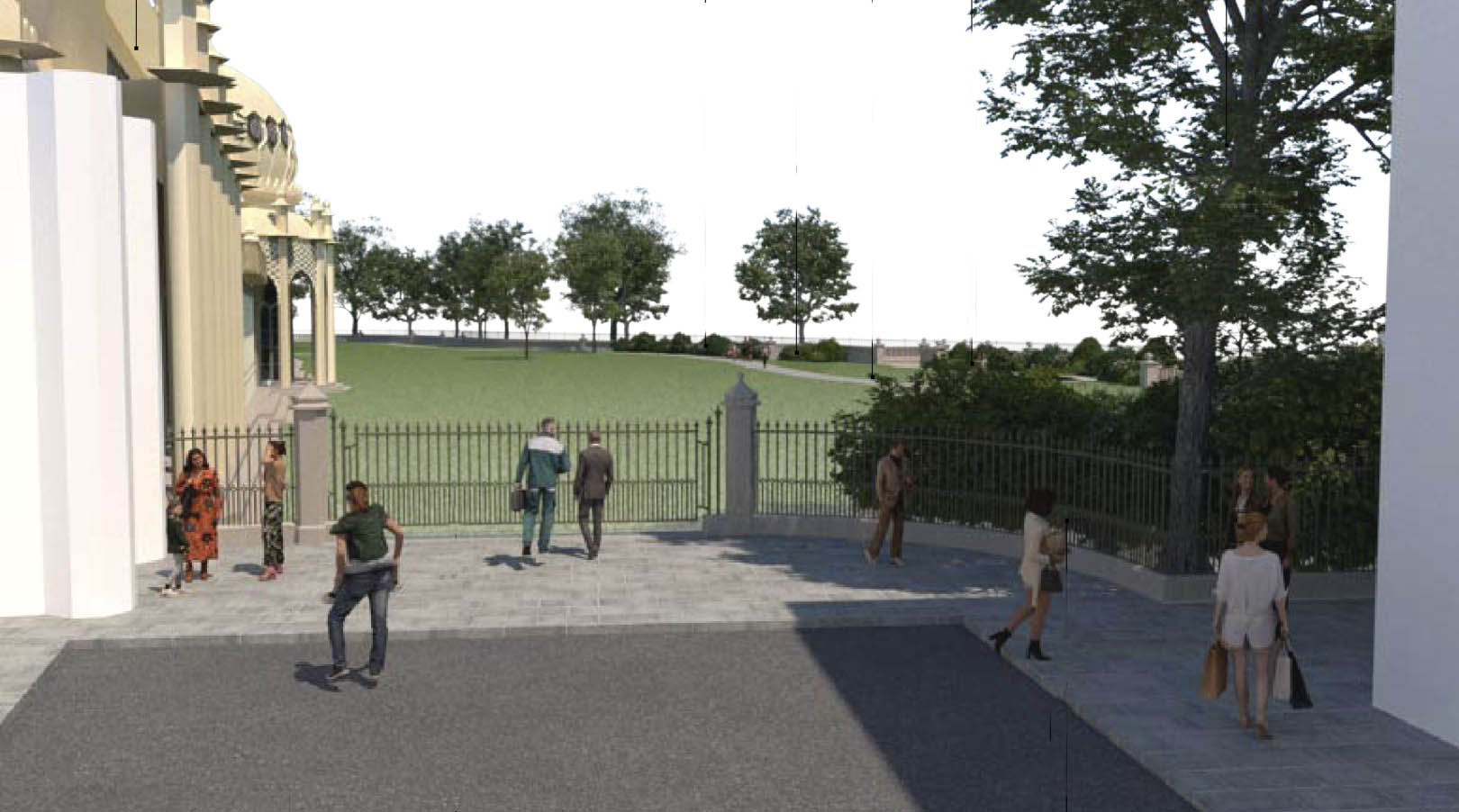
The Royal Pavilion Gardens are heavily used during much of the year. They form the setting for the Royal Pavilion itself as well as the Museum, the Dome and the Corn Exchange. They also provide a welcome public green open space in the heart of the city centre and an important pedestrian route between North Street and Church Street.
We fully support the proposals to improve the general condition of the gardens. It has to be said that they are looking down at heel and suffering from the consequences of over-use and under-maintenance. There is a lack of consistency in the detailing of the garden infrastructure and many features are clearly past their sell-by date. There is poor signage and a hotch-potch of inappropriate garden furniture. We therefore support plans to improve the footpaths, refresh the planting, improve vistas, instal new lighting, rationalise the furniture, etc.
However, we oppose the plans to enclose the gardens with high metal fencing and lockable gates and thus transform what has been a public garden for 170 years into a stockaded enclave. We understand that although the aim is to create a lockable perimeter, the current plan is that the gates should always remain open. This being the case, why create the barrier in the first place?
In this regard, we support the objections recorded by Living Streets and The North Laine Community Association. The design of the proposed fencing is both ugly and oppressive, particularly when it is applied clumsily to the two historic gateways. We deplore the deliberate sleight of hand in the application where the impact of 2.1m-high fencing is minimised by adding figures that are two metres tall.
We are aware that there is a problem of anti-social behaviour in the gardens, particularly at night. However, we believe that this problem would be better addressed by making the gardens more open, improving lighting and increasing supervision and policing.
We do accept, however, that there is a case for enclosing the eastern garden that lies between the Pavilion and the Steine. That garden is not a thoroughfare and is used for special events. The current faux-Indian wall and bow-topped fencing could be replaced by a single 1.5m fenced enclosure with lockable gates (with a design based on the existing fencing in the south-east corner of the garden)
We believe that any changes to vistas should take into account the current situation rather than trying to recreate views from the time of Nash. In particular attempts should be made to improve views of the Dome, while screening the service area and views of the two historic gateways. We also feel strongly that the views from New Road towards the Pavilion should be opened up in order to create improved links between the gardens and New Road. To this end we support the removal of the long bench than runs along the east side of New Road. But we would go further and replace the narrow, dark, chicaned entrance pathways in the north-west and south west-corners with a much wider and open access via the café and the café terrace. The existing café and terrace should be given a face-lift and extra seating should be added.
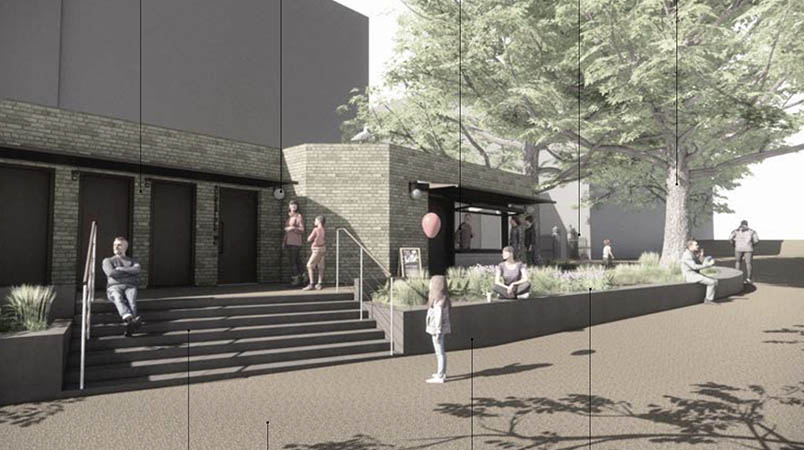
We also oppose plans to alter the public toilets which lie on the southern edge of the gardens and are currently accessed from Princes Place. They are the only public toilets in the central area of the city and serve the North Street area as well as the gardens. The changes reduce the toilet provision by two-thirds and insert a wholly inappropriate food vending kiosk. Again, we acknowledge that the toilets currently are beset with behavioural problems, but suggest that these could be solved with improved design and better supervision.
Images are from the planning application, which is available online.
Posted 6 January 2024
Planning forum: December 2023
The Planning Forum, attended by members of the Regency Society and Hove Civic Society hovecivicsociety.org meets monthly to discuss planning applications which the Forum considers significant. Each society may form its own view on the applications and decides what action, if any, to take, although we generally try to respond jointly.
These are the applications we have commented =on following the December 2023 meeting.
Mucking about with a mews
BH2023/02607 4 Kemp Town Place
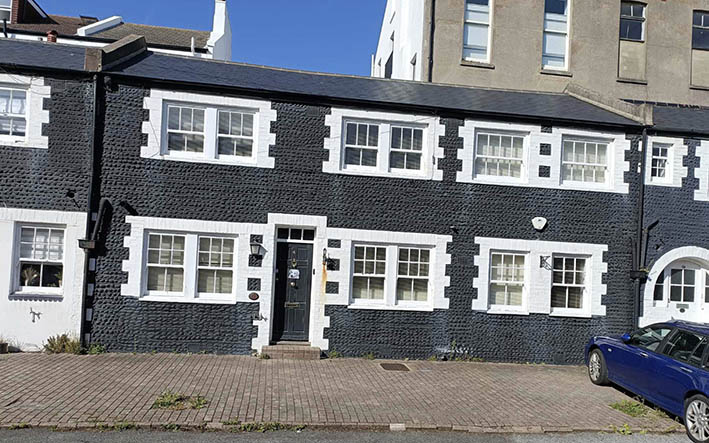
The Regency Society and the Hove Civic Society object to this application for ‘alterations to front elevation incorporating double doors to replace sash window, access ramp and replacement front door. Internal alterations to ground floor layout’.
No 4 is one of a group of similar but not identical Grade II listed properties forming both sides of the former mews within the Kemp Town Conservation Area. The proposed external alterations and the intrusive access ramp would adversely affect the significance not just of No 4 but of the whole group. They would be detrimental to the setting of the other buildings in the group, as well as to the character of the Conservation Area.
There would be no public benefit commensurate to the substantial harm done to this listed building. The claimed benefit that the proposal would 'improve wheelchair access to and circulation within the property' is negated by the absence of a wheelchair-accessible WC within the property, now or proposed.
Not glad about the cladding
BH2023/02027 64 Edward Street
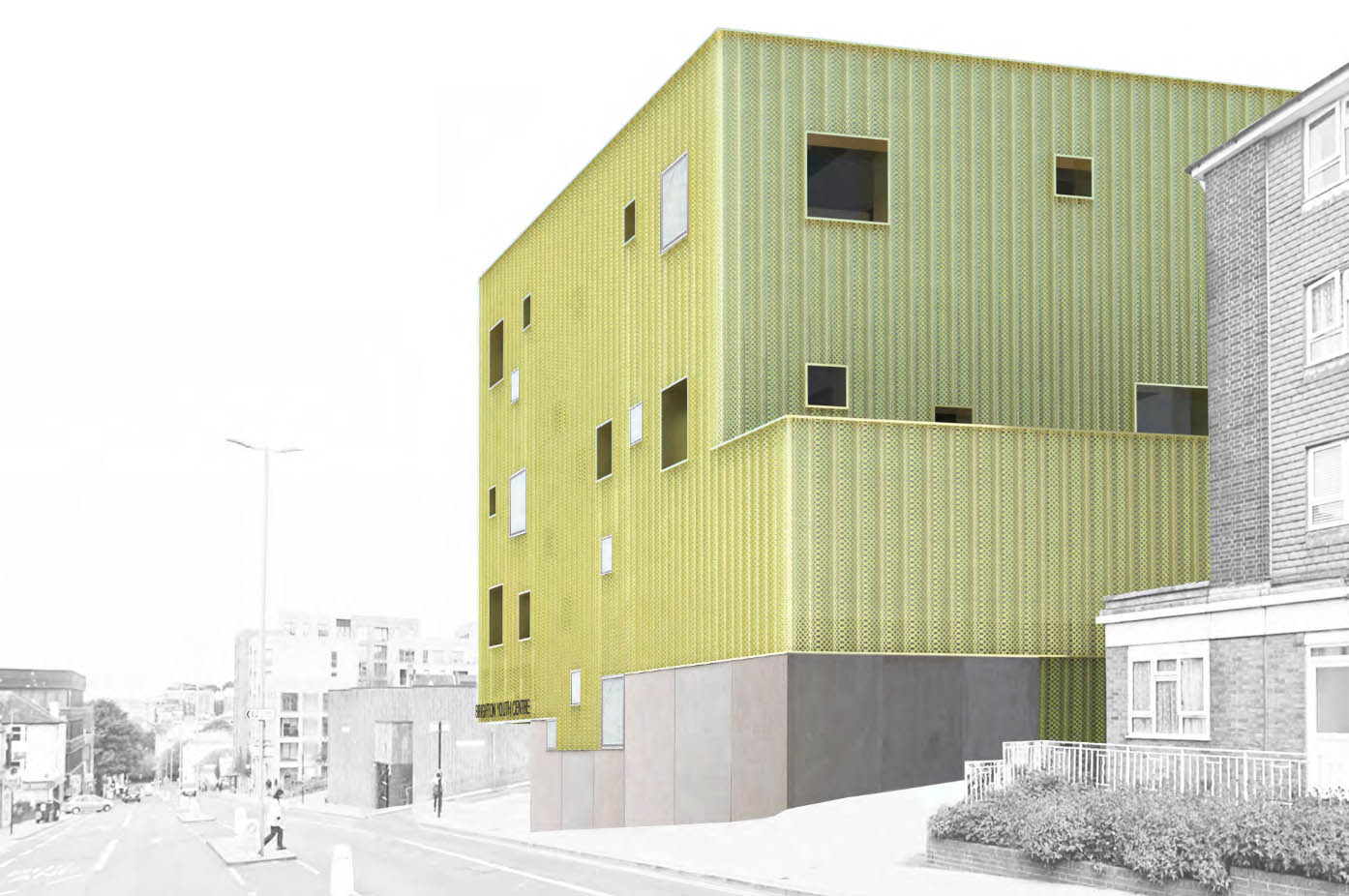
The Regency Society and the Hove Civic Society object to this application for the ‘Redevelopment of Youth Centre to provide shared exhibition, performance and workshop spaces, along with a skate park, climbing wall and sports hall’.
It is our view that the choice of external cladding is inappropriate. The description of the primary wall cladding on the drawings is ‘fluted gold perforated panels’. This is a totally unacceptable choice for a building on the edge of the East Cliff Conservation Area and which terminates the view up Devonshire Place.
Not quite to the point
BH2023/02349 Enterprise Point and Melbourne Street
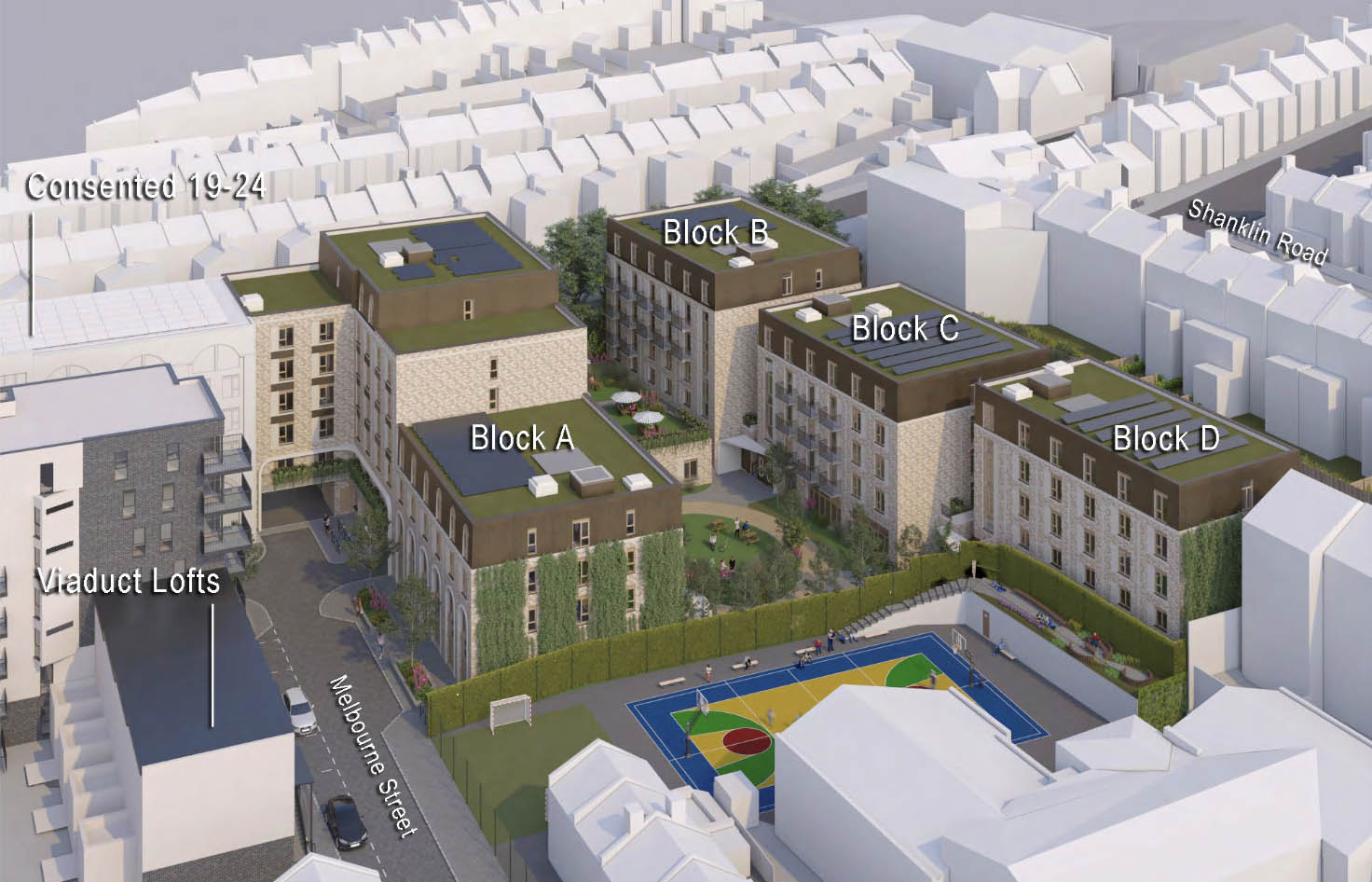
The Regency Society and the Hove Civic Society object to this application for the ‘demolition of the existing buildings and erection of a new development of four to seven storey buildings’.
It is our view that the following issues need to be addressed:
- there is not enough soft landscape
- the buildings are too close together
- there are minimal open spaces
- some of the accommodation units will have low levels of sunlight
At least two floors too much
BH2023/02311 145-151 Kingsway, Hove BN3 4GR
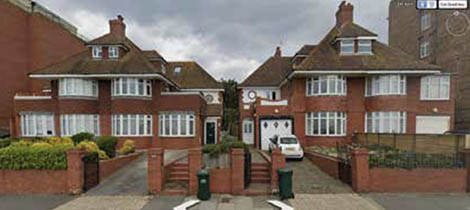
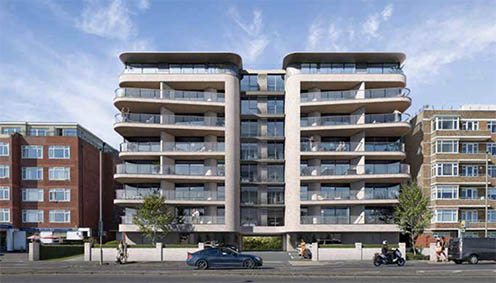
Hove Civic Society and Regency Society jointly object to this proposal.
• The height and bulk of the design are excessive in the context of the streetscape. The effect of the development would be an overwhelming presence in the streetscape between Hove Street to the east and Princes Crescent to the west.
• The height would dominate the neighbouring buildings on either side of the site: an appropriate maximum height should be lower than the height of Viceroy Lodge to the east.
• The heaviness of the proposed front elevation would also dominate the whole frontage between Hove Street and Princes Crescent: a more sympathetic design approach is needed.
• These shortcomings are particularly important given that the site sits within a conservation area. Whatever the criticisms about some of the existing buildings in this particular section of Kingsway, it cannot credibly be argued that the development (as now proposed) would improve the conservation area (compared with the present buildings). The scheme would actually harm the character and appearance of the conservation area. And there is of course a statutory presumption against granting permission for a development in these circumstances.
We are very disappointed that the proposed scheme falls short of attention to the quality landscaping that might be expected, and to improvement of the public realm. This is all the more disappointing given the major efforts currently being made by the Council to improve the landscaping and amenity of the ‘Kingsway to the Sea’ linear park, to the south of Kingsway.
See also our comments on the Royal Pavilion Gardens.
Images are from the planning applications. Click on the application numbers to open from the Brighton & Hove City Council planning portal in a new tab
Posted 6 January 2024

